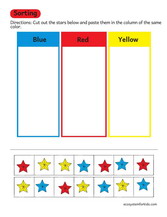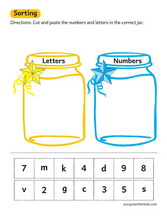Sorting Shapes Worksheet Kindergarten Pdf
This page features sorting shapes worksheet kindergarten pdf. In these sheets children will learn to sort out and classify objects like toys or shapes according to their size, shape type or color. This activity is relevant to everyday life since we are always sorting items like clothes, fruits or vegetables. Click and print to practice with your kindergarteners.
Skip counting and finding next numbers
Skip count kindergarten worksheet
How to Introduce Sorting and Ordering in Kindergarten
If you are wondering how to introduce sorting and organizing in kindergarten, here are a few ideas. Objects, keys, and toys are all good examples of objects that children can sort. A child quickly learns to distinguish between similar objects and choose the right order to achieve a desired result. To make learning fun, sorting objects can also be a good way to reinforce a particular concept.
This basic skill helps kids develop their observational abilities and form their early literacy and numeracy skills. Many adults classify objects or ideas into categories for convenience. Some of us do this daily by storing certain items in our refrigerator, while others put them on a shelf in their closet. Sorting and organizing tasks in kindergarten encourage the child to use his or her imagination and make connections between different things that are similar or dissimilar.
Classifying
Classifying objects in kindergarten begins with sorting by color, shape, and size. A child may choose more than one attribute or choose to sort objects by his or her own choice. Initially, a child sorts objects by one attribute and then moves on to other attributes, such as counting and comparing. As the child gets older, the sorting task can be extended to other categories and/or include a larger vocabulary.
Patterning
Recognizing patterns in sorting and ordering is an important skill for early childhood education. Sorting and ordering objects is about recognizing properties, characteristics, and relationships. By the end of kindergarten, children should have the basic ability to recognize and form simple patterns. Teachers should give children ample opportunities to practice and let them create their own categories and patterns. Teachers should also encourage students to explain their thinking and use manipulatives to enhance their learning.
Sorting Objects
The process of sorting and ordering objects is a precursor to learning to count and deal with numbers. In addition, children develop greater vocabulary by using the terms "er" and "est," which denote increasing and decreasing amounts of an attribute. Use crisps and sticks that are larger or smaller and ask children to tell you which ones are larger or smaller. Also ask them to sort them.
Materials Need For Kinder
There is so much to love about this age group, from the cute little animals to the wonderful new concepts it brings. Here are four great ideas for materials to use in your classroom. Create a class calendar, set up a class library, and stock up on classroom essentials so you have everything you need when the kids start school. As soon as they start seeing items lying around, they start playing with them. One thing that kids would tend to do is creare patterns, sort out objects and build things out of shapes. Make sure your class is fully equipped with these.
Objects in a tray
Objects in a tray for sorting and ordering exercises in kindergarten develop basic matching and generalization skills. Students sort objects by colors, textures, sizes, or shapes. Some students like to compare shapes and may go on a "shape hunt" to find different objects with the same shape. Using different materials and shapes, they can also sort pictures of different shapes. Try printing out the worksheets on this page. They contain pictures of objects that the children can sort using the instructions.
Sorting pine cones
Sorting pine cones in kindergarten is not only a great sensory activity for kindergarten, but it also allows you to teach your children about the different types and sizes of pine trees. Kids can study the structure of a pine cone by measuring the size of each cone, and they can also observe how pine seeds move in the wind. Using a variety of natural elements, they can also build a pine cone weather forecasting station, just for fun. They can also try to make a weather forecast by measuring and recording the size of each pine cone. When they are finished, let them dry the cones.
Sorting buttons
This activity helps children develop their fine motor skills. This activity can be done with inexpensive materials that you can find in any supermarket. It encourages children to think in terms of colors and sizes and is a great way to teach them the difference between similar and different objects. If you are looking for ideas for sorting buttons, start with worksheets that include pictures of buttons before resorting to real buttons.


